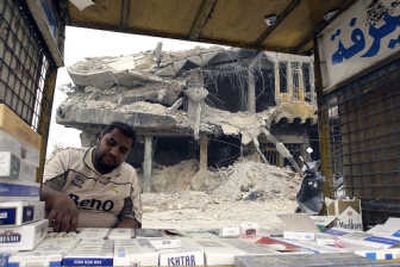Push on to rebuild Sadr City

BAGHDAD – Hundreds of women in black abayas crowd outdoor food markets, snapping up groceries and fresh vegetables. Stores are open again. Children play soccer on dirt fields until dusk – or later, when there’s electricity.
This is Sadr City, where black-clad militiamen of radical Shiite cleric Muqtada al-Sadr’s Mahdi Army once enforced discipline across the sprawling slum of 3 million people – half of Baghdad’s population. The Iraqi army won control of the district in May after weeks of battles that damaged scores of houses and emptied the streets.
“Security is better without the Mahdi Army,” said a 42-year-old resident who wanted to be identified only by his nickname, Abu Israa. “We don’t want them back.”
Most residents do not seem to miss the Mahdi Army, and the U.S. and Iraqi governments hope that sentiment sticks. So Sadr City is witnessing a flurry of public works projects – part of an effort to build confidence in the government and make it more difficult for the extremists to return.
The U.S. military has tried the same strategy before in Sadr City after cease-fires but with limited results. This time U.S. officials are more confident that they can do a better job of managing the effort and maintaining the flow of money. They also believe that support for the militia has dropped sharply because residents are tired of bloodshed.
The Iraqis apparently hope to avoid the disappointment that’s growing in the southern city of Basra, where many residents blame the government for failing to deliver on its promises to improve basic services, provide jobs and distribute enough food after winning control from Shiite militias last spring.
Taking no chances in Sadr City, hundreds of city workers have spread out across the district to spruce it up. They are resurfacing roads and sidewalks, repairing the sewer system and collecting garbage.
Prime Minister Nouri al-Maliki has pledged $100 million to upgrade the quality of life. The U.S. military is also providing some reconstruction and economic aid to help rebuild parts of Sadr City – with about $4 million already being spent and more on the way.
“The Iraqi government is rebuilding Iraq, one area at a time,” says a large billboard on one of Sadr City’s main roads – part of a U.S.-backed propaganda effort.
U.S. troops continue to stay in the area’s outlying neighborhoods, but residents report nightly forays by American forces and their Iraqi allies to arrest Mahdi Army commanders – moves the government once roundly condemned and the Mahdi Army pledged never to allow.
With a canny mix of persuasion and intimidation, Mahdi Army fighters and clerics loyal to al-Sadr had governed the enclave since 2003 like a mini-state. They set up Islamic courts, punished offenders and operated hospitals and gas stations.
Residents tolerated the abuses because the militiamen protected them from Sunni militants during sectarian strife in Baghdad in 2006 and 2007. But when violence abated, so did the Mahdi Army’s welcome.
Behind the scenes, al-Sadr is quietly reorganizing the militia into a smaller force to fight again, according to a senior militia commander. But publicly, the Mahdi Army has melted away.
Gone are the small groups of militiamen hanging out on major roads or racing through dusty streets in pickup trucks. They have even stopped guarding al-Sadr’s office and manning checkpoints to search worshippers headed to outdoor Friday prayers.
Many commanders have gone into hiding or fled. But others say this is just a waiting period.
“We are still here even if you don’t see us,” said Mahdi al-Freiji, one militiaman. “There is a time for everything. You just have to wait and see.”